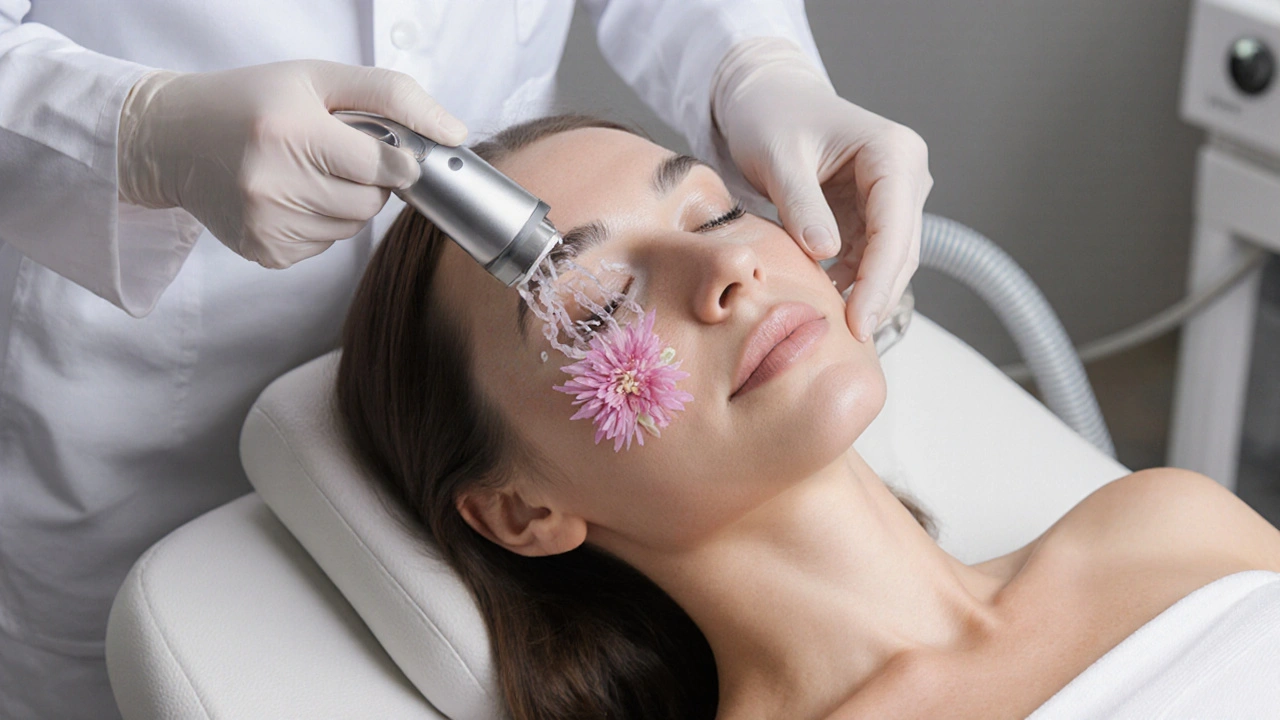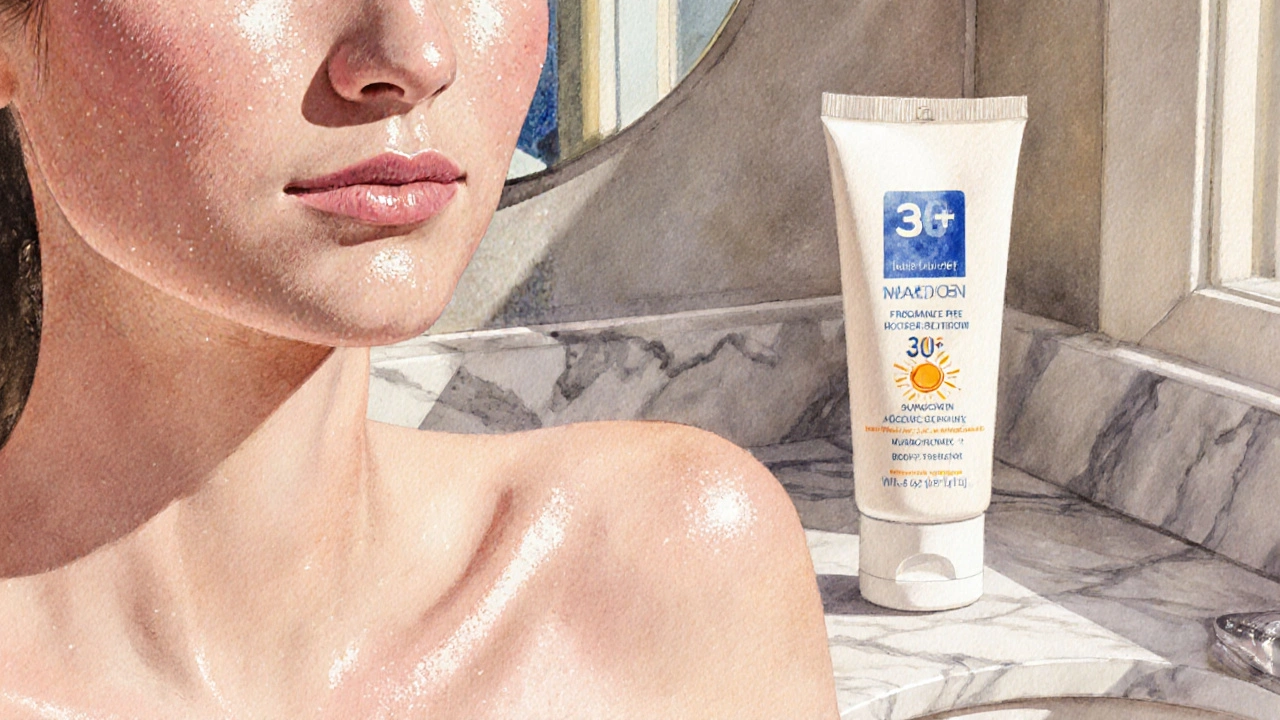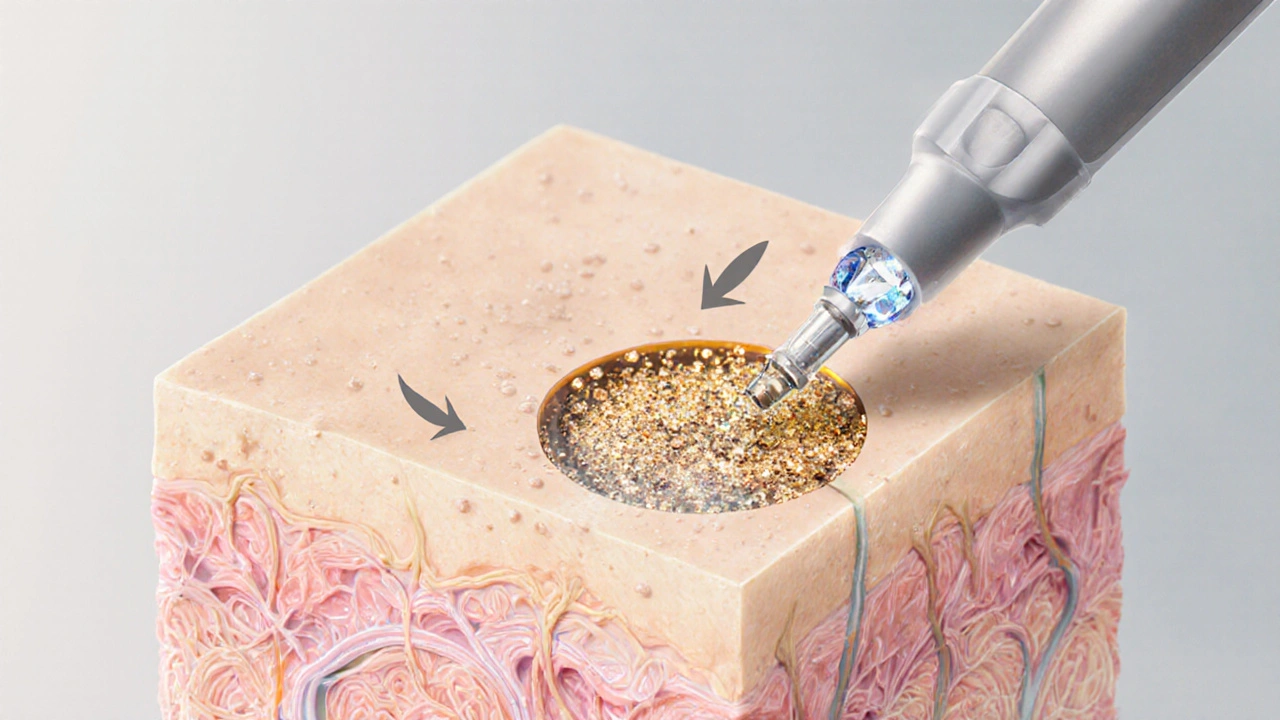Microdermabrasion vs. Chemical Peel Comparison Tool
Superficial exfoliation using fine crystals or diamond tips. Ideal for mild-to-moderate acne, enlarged pores, and post-inflammatory hyperpigmentation.
- Depth 0.1–0.3 mm
- Downtime Minimal
- Best for Active Acne Yes
- Cost per Session $80–$150
Deeper exfoliation using acids to remove damaged skin layers. Effective for moderate acne and pigmentation issues, but requires more recovery time.
- Depth 0.2–1.0 mm
- Downtime 1–3 days
- Best for Active Acne Limited
- Cost per Session $120–$250
| Aspect | Microdermabrasion | Chemical Peel |
|---|---|---|
| Depth of Exfoliation | 0.1–0.3 mm | 0.2–1.0 mm |
| Downtime | None to few hours | 1–3 days |
| Best for Active Acne | Yes – reduces clogged pores | Limited – can irritate inflamed lesions |
| Cost per Session (US) | $80–$150 | $120–$250 |
| Recovery Time | Immediate | 1–3 days |
| Procedure Duration | 30–45 minutes | 30–60 minutes |
Which Treatment Is Right for You?
Choose Microdermabrasion if: You want a quick, gentle treatment with minimal downtime, ideal for mild-to-moderate acne and sensitive skin.
Choose Chemical Peel if: You're dealing with deeper acne scarring or more severe acne and can afford a few days of recovery.
When it comes to tackling stubborn breakouts, Microdermabrasion is a non‑invasive exfoliation technique that uses fine crystals or a diamond tip to gently remove the outermost skin layer. The result? Smoother skin, fewer blemishes, and a noticeable boost in confidence. Below we break down exactly how this treatment helps acne‑prone skin, what you’ll feel during the session, and the steps you should follow after the procedure.
Why Microdermabrasion Works on Acne
Acne forms when hair follicles get clogged with excess Sebum (an oily substance that lubricates the skin) and dead skin cells. The build‑up creates an environment where bacteria thrive, leading to inflammation and breakouts.
- Collagen (a protein that provides structure and elasticity to the skin) production can be stimulated by the controlled micro‑injuries created during the procedure, helping to repair the damaged tissue.
- Keratinocytes (the predominant cells in the epidermis that produce keratin) are sloughed off more efficiently, preventing the formation of new comedones.
- The treatment improves the Skin barrier (the outermost layer that protects against irritants and microbes), reducing the chance of irritation after topical acne meds.
In short, microdermabrasion tackles the root causes of acne - excess oil, clogged pores, and inflammation - while also encouraging the skin’s natural healing processes.
What to Expect During the Session
A typical appointment lasts 30‑45 minutes and follows three simple steps:
- Consultation: A board‑certified Dermatologist (a medical professional specialized in skin health) examines your skin type, evaluates the severity of acne, and decides if microdermabrasion is suitable.
- Preparation: The skin is cleansed and a gentle pre‑treatment serum may be applied to enhance crystal adhesion.
- Exfoliation: The device’s handpiece glides over your face, delivering a fine stream of crystals (or using a diamond tip) that lifts away dead cells. You’ll feel a light buzzing sensation, comparable to a mild facial massage.
Most patients describe the feeling as “refreshing” rather than painful. A suction system simultaneously removes the spent crystals and any debris, leaving the skin feeling smoother immediately after.

Immediate After‑Effects
Because the outermost layer is only lightly abraded, downtime is minimal. Typical post‑treatment signs include:
- A subtle pink flush that fades within a few hours.
- Mild tightness, which can be soothed with a hydrating serum.
- Increased sensitivity to sunlight - a reminder to wear sunscreen.
If you notice prolonged redness or unexpected swelling, contact your dermatologist right away.
Best‑Practice Aftercare Routine
Following a smart aftercare plan maximizes results and keeps irritation at bay.
- Hydrate: Apply a fragrance‑free moisturizer containing ceramides to restore the skin barrier.
- Protect: Use a broad‑spectrum SPF 30+ daily. UV exposure can reverse the collagen‑boosting effect.
- Avoid harsh actives: Hold off on retinoids, benzoyl peroxide, or salicylic acid for 48‑72hours. These can exacerbate sensitivity.
- Gentle cleansing: Stick to a mild, sulfate‑free cleanser. Pat, don’t rub, the skin dry.
Most dermatologists recommend a series of 4‑6 sessions spaced 2‑4 weeks apart for optimal acne control.
Pros, Cons & Who Should Consider It
Like any cosmetic procedure, microdermabrasion has its strengths and limitations.
| Aspect | Microdermabrasion | Chemical Peel |
|---|---|---|
| Depth of exfoliation | Superficial (0.1‑0.3mm) | Variable (0.2‑1mm) |
| Downtime | None‑to‑few hours | 1‑3 days (redness, flaking) |
| Best for active acne | Yes - reduces clogged pores | Limited - can irritate inflamed lesions |
| Cost per session (US) | $80‑$150 | $120‑$250 |
Key takeaways:
- Pros: minimal downtime, immediate skin smoothness, stimulates collagen, suitable for sensitive or active acne.
- Cons: results are gradual; heavy scarring may need deeper resurfacing techniques.
- Ideal candidates: people with mild‑to‑moderate acne, enlarged pores, or post‑inflammatory hyperpigmentation who prefer a gentle, low‑risk option.

Common Concerns & Safety Tips
Many ask whether microdermabrasion can worsen acne or cause scars. The answer hinges on proper technique and professional oversight.
- Always have the procedure performed by a qualified Dermatologist or licensed aesthetician trained in acne care.
- Avoid the treatment if you have active skin infections, open wounds, or a history of allergic reactions to crystal materials.
- Discuss any current acne medications - some (like isotretinoin) may require a waiting period to prevent excessive dryness.
When done right, the odds of adverse effects are low, and most patients see a clearer complexion within a few weeks.
Key Takeaways
- Microdermabrasion gently removes dead skin cells, unclogs pores, and jump‑starts collagen production.
- Typical sessions last 30‑45minutes with little to no downtime.
- Follow a post‑procedure routine of hydration, sun protection, and temporary avoidance of strong actives.
- Best suited for mild‑to‑moderate acne, oily skin, and those seeking minimal interruption.
- Compared with chemical peels, microdermabrasion offers a safer, quicker recovery while still delivering measurable improvement.
Frequently Asked Questions
How many microdermabrasion sessions do I need for acne?
Most dermatologists recommend a series of 4‑6 treatments spaced 2‑4 weeks apart. Visible reduction in breakouts often appears after the third session, with continued improvement over the next few months.
Can I combine microdermabrasion with my current acne medication?
Yes, but timing matters. Topical retinoids or benzoyl peroxide should be paused 48‑72hours before and after each session to avoid irritation. Oral antibiotics or hormonal therapies can usually continue uninterrupted.
Is microdermabrasion safe for sensitive skin?
When performed by a qualified professional, it’s safe for most skin types, including sensitive. The procedure’s superficial depth minimizes the risk of over‑exfoliation. Always discuss skin sensitivities during the initial consultation.
Will microdermabrasion help with acne scars?
It can improve mild atrophic scars by stimulating collagen, but deeper or rolling scars may need laser resurfacing or microneedling for noticeable change.
What should I avoid right after the treatment?
Skip heavy makeup, harsh scrubs, and direct sun exposure for at least 24hours. Stick to gentle, fragrance‑free products and apply sunscreen liberally.


It is imperative to recognize that the proliferation of microdermabrasion clinics coincides suspiciously with the recent surge in pharmaceutical lobbying for topical retinoids. The industry narrative emphasizes superficial benefits while deliberately obfuscating long‑term dermal alterations. Moreover, the proprietary crystal formulations are seldom disclosed, suggesting an intentional veil over potential adverse systemic absorption. Patients are encouraged to pursue frequent sessions, thereby generating a steady revenue stream that appears to be coordinated with larger skincare conglomerates. Independent dermatological studies, regrettably, are scarce, reinforcing the hypothesis of concealed data manipulation. Consequently, a prudent individual should question the purported safety claims before committing to repeated procedures.
Thanks for the insight
From an epistemic standpoint, microdermabrasion functions as a tactile phenomenology of skin renewal. The crystal particles act as micro‑agents that displace keratinocyte aggregates, facilitating a cascade of cellular turnover. In lay terms, think of it as a gentle sandblasting that smooths the canvas of the face. This process aligns with the principle of hormesis, where controlled stress elicits adaptive repair mechanisms. By modestly perturbing the epidermal barrier, we invoke a feedback loop that upregulates collagen synthesis. The resulting biomechanical equilibrium often translates into reduced pore congestion and diminished inflammatory lesions. However, the intervention remains superficial, so deeper dermal scars may require adjunctive modalities. Ultimately, the modality serves as a pragmatic bridge between passive cleansing and more invasive resurfacing techniques.
I understand your enthusiasm and appreciate the clear breakdown you offered. The explanation strikes a balance between technical detail and accessible language, which is especially valuable for newcomers. It’s important to remember that individual skin responses can vary, and what works for one may not work for another. If you decide to try the treatment, ensure you consult a qualified professional and discuss any existing conditions. Also, keep an eye on post‑procedure irritation; it’s normal but should subside quickly. Definately stay vigilant about sunscreen use to protect the newly exfoliated layers.
Oh great another "miracle" that promises flawless skin while barely costing a coffee. Who needs real results when you can pay for a fancy buzz and a quick Instagram filter? It's basically a glorified facial with a side of vanity.
The insinuation that microdermabrasion is merely a vanity exercise discounts a substantial body of peer‑reviewed evidence demonstrating measurable reductions in comedonal obstruction. While you dismiss the procedure as a "glorified facial," the data indicate statistically significant improvements in pore size and post‑inflammatory hyperpigmentation after a course of four to six sessions. Moreover, the alleged financial burden is marginal when juxtaposed against the long‑term costs associated with chronic acne medication regimens that often entail systemic side effects. Your flippant commentary betrays a lack of due diligence and an alarming propensity to undermine legitimate dermatological interventions. Such rhetoric not only misleads the uninformed public but also fuels unwarranted skepticism that hampers evidence‑based practice. It is incumbent upon critics to substantiate their claims with empirical findings rather than resorting to snide quips.
Microdermabrasion can be an excellent addition to an acne treatment plan when used correctly. First, schedule a thorough skin analysis with a board‑certified dermatologist to determine if your skin type and acne severity are appropriate for this modality. The procedure typically lasts between thirty and forty‑five minutes, during which fine crystals or a diamond tip gently abrade the stratum corneum. You will feel a mild buzzing sensation, which most patients describe as soothing rather than painful. Following the treatment, the skin may exhibit a faint pink flush that usually resolves within a few hours. Apply a fragrance‑free, ceramide‑rich moisturizer immediately after to reinforce the skin barrier and reduce transepidermal water loss. Because the epidermis is partially compromised, diligent sunscreen use with at least SPF 30 is essential for the next 24‑48 hours. Avoid harsh actives such as retinoids, benzoyl peroxide, or salicylic acid for at least three days to prevent irritation. Gentle cleansing with a sulfate‑free cleanser is recommended twice daily, and you should pat the skin dry rather than rub. Hydration remains a cornerstone of recovery; consider integrating a hyaluronic acid serum to maintain moisture levels. For optimal results, plan a series of four to six sessions spaced three to four weeks apart, allowing the skin sufficient time to remodel. Monitor your progress with periodic photographs taken under consistent lighting to assess changes in pore size and lesion count. If you experience prolonged redness, swelling, or signs of infection, contact your dermatologist promptly. Lastly, remember that microdermabrasion addresses superficial acne and may need to be combined with other therapies, such as topical antibiotics or hormonal treatments, for comprehensive management.
Thanks helpful info i will try the moisturiser suggestion
Because who doesn’t love paying for a sandpaper facial?
The discourse surrounding microdermabrasion often masquerades as benign consumer advice while covertly perpetuating a neoliberal commodification of self‑care 😒. By framing skin refinement as an individual responsibility, the industry diverts scrutiny from systemic inequities in dermatological access. Moreover, the purported “minimal downtime” is a rhetorical device designed to accelerate consumption cycles. Empirical scrutiny reveals that repeated superficial ablation can paradoxically exacerbate barrier dysfunction in predisposed individuals, a fact conveniently omitted from marketing narratives. Thus, the hype is less about dermatologic benefit and more about capital extraction.
Interesting take, I hadn’t considered the broader economic angle. While I agree that cost can be a factor, many people also genuinely enjoy the confidence boost they get from clearer skin. It’s a nuanced issue, and I think personal experience should also weigh in alongside the critiques.